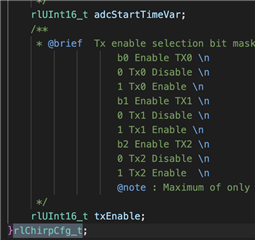Hi,
We have an AWR2243 which we are using with the TI supplied example Cascade_Configuration_MIMO.lua script.
The script uses 12 transmitters across the 4 devices to give us 192 virtual receivers.
ramp_end_time is set to 40us and chirp_loops is set to 64.
Q1 - It looks like this script is setting up to use TDM (and not BPM), can anyone confirm this?
Q2 - If this is the case would it be correct to assume that total frame capture time would be 40 x 64 x 12 = 30.72ms?
Q3 - Can this frame time be reduced by using BPM at all?
Many thanks!


